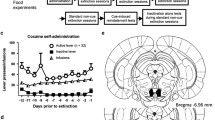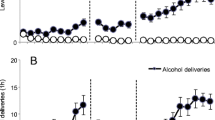Abstract
32 male rats, of which half had sustained small electrolytic lesions in the medial septal area and half had received sham operations, were trained on continuous reinforcement to run an alley for water reward and then given four days of extinction testing. Half of both the lesioned and sham-operated groups were given sodium amylobarbitone on Days 1 and 2 of extinction and the other half on Days 3 and 4, saline being administered on non-drug days. The drug, unusually, decreased resistance to extinction. This effect was probably due to the subjects having taken part in a previous experiment in which they had received, without drugs, training and extinction under the same conditions as in this experiment. In the goal section of the alley, the drug effect was greater in lesioned than shamoperated rats. The lesions retarded extinction, and this effect was reduced by the drug. A model for the neural loci at which amylobarbitone acts to affect resistance to extinction, based on these and other results, is proposed.
Similar content being viewed by others
References
Barry, H. III., Wagner, A. R., Miller, N. E.: Effects of alcohol and amobarbital on performance inhibited by experimental extinction. J. comp. physiol. Psychol. 55, 464–468 (1962).
Becker, P. W., Bruning, J. L.: Goal gradient during acquisition, partial reinforcement, and extinction of a five part response chain. Psychon. Sci. 4, 11–12 (1966).
Butters, N., Rosvold, H. E.: Effect of caudate and septal nuclei lesions on resistance to extinction and delayed alternation. J. comp. physiol. Psychol. 65, 397–403 (1968).
Gray, J. A.: Sodium amobarbital and effects of frustrative nonreward. J. comp. physiol. Psychol. 69, 55–64 (1969).
—: Sodium amobarbital, the hippocampal theta rhythm and the partial reinforcement extinction effect. Psychol. Rev. 77, 465–480 (1970).
- Effects of septal driving of the hippocampal theta rhythm on resistance to extinction. Physiol. Behav. (in press, a).
- The psychophysiological basis of introversion-extraversion: a modification of Eysenck's theory. In: V. D. Nebylitsyn and J. A. Gray (Eds.): The biological bases of individual behaviour. New York: Academic Press (in press, b).
—, Ball, G. G.: Frequency-specific relation between hippocampal theta rhythm, behaviour and amobarbital action. Science 168, 1246–1248 (1970).
- Quintão, L., Araujo-Silva, M. T.: The partial reinforcement extinction effect in rats with medial septal lesions. Submitted to Physiol. Behav. (in preparation).
Harvey, J. A., Heller, A., Moore, R. Y., Hunt, H. F., Roth, L. J.: Effect of central nervous system lesions on barbiturate sleeping time in the rat. J. Pharmacol. exp. Ther. 144, 24–36 (1964).
Killam, E.: Drug action on the brain-stem reticular formation. Pharmacol. Rev. 14, 175–223 (1962).
König, J. F. R., Klippel, R. A.: The rat brain: A stereotaxic atlas of the forebrein and lower parts of the brain stem. Baltimore: Williams and Wilkins 1963.
Livingston, R. B.: Discussion of E. Grastyan's paper. In: M. A. B. Brazier (Ed.): Central nervous system and behaviour, 2nd conference, pp. 153–156. New York: Josiah Macy Jr. Foundation 1959.
McCleary, R. A.: Response-modulating functions of the limbic system: Initiation and suppression. In: E. Stellar and J. M. Sprague (Eds.): Progress in physiological psychology, Vol. 1, pp. 209–272. New York: Academic Press 1966.
Miller, N. E.: The analysis of motivational effects illustrated by experiments on amylobarbitone. In: H. Steinberg (Ed.): Animal behaviour and drug action, pp. 1–18. London: Churchill 1964.
Raphelson, A. C., Isaacson, R. L., Douglas, R. J.: The effect of distracting stimuli on the runway performance of limbic damaged rats. Psychon. Sci. 3, 483–484 (1965).
Stumpf, Ch.: Drug action on the electrical activity of the hippocampus. Int. Rev. Neurobiol. 8, 77–138 (1965).
Winocur, G., Mills, J. A.: Hippocampus and septum in response inhibition. J. comp. physiol. Psychol. 67, 352–357 (1969).
Author information
Authors and Affiliations
Rights and permissions
About this article
Cite this article
Gray, J.A., Araujo-Silva, M.T. Joint effects of medial septal lesions and amylobarbitone injections on resistance to extinction in the rat. Psychopharmacologia 22, 8–22 (1971). https://doi.org/10.1007/BF00401462
Received:
Issue Date:
DOI: https://doi.org/10.1007/BF00401462




